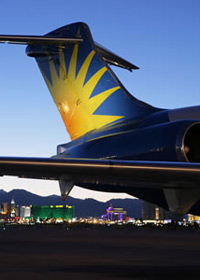When Maurice Gallagher took over Allegiant Air in 2001, it was a bankrupt carrier operating one route with a single McDonnell Douglas DC-9. Today Allegiant is a profitable low-cost carrier operating 68 routes with 26 Boeing MD-80s.
Gallagher, who in the 1990s founded and led low-cost carrier ValuJet, says Allegiant’s growth period has just started. Having raised $90 million from an initial public offering (IPO) late last year, Allegiant plans to double its network and fleet over the next five years.
Allegiant has a business model that may seem familiar in Europe and Canada but is unheard of in the USA. Allegiant serves 48 small airports with full-size aircraft, operating low-frequency services to three popular leisure destinations.
“It’s unique and very defensible. We have very little competition,” Gallagher says.
Allegiant, he says, provides “vacation experiences” for residents of small US communities that generally only have high-cost air links to hub cities and business destinations rather than low-cost flights to holiday destinations. These residents are offered combination deals that package non-stop point-to-point flights with hotels, rental cars and theme park or show tickets.
“We’re a travel company. We just happen to be an airline,” Gallagher says.
Almost all of Allegiant’s passengers are heading to one of three leisure destinations or focus cities: Las Vegas (famous for casinos) Orlando (home to Disney World) or St Petersburg/Clearwater on Florida’s west coast (known for its beaches). Gallagher says less than 10% of its passengers on the Las Vegas and Orlando flights are from Las Vegas or Orlando and only 20% of its passengers on the St Petersburg/Clearwater flights reside in Florida.
 Carving a niche
Carving a niche
Allegiant is based in Las Vegas, where Southwest Airlines and US Airways subsidiary America West Airlines have hubs. But after Gallagher took over the carrier he decided to intentionally stay away from routes operated by these two carriers and other mainline operators.
“We consciously set out a programme where we go where they ain’t,” Gallagher says.
“We’re the only carrier in the last 20 years that has broke out of the hub mould.”
Allegiant also has been the only US carrier to launch an aggressive campaign to increase ancillary revenues, following the example of European low-cost guru Ryanair. Ancillary revenues now account for 17.5% of Allegiant’s overall revenues, or $16 per passenger. Gallagher says on average ancillary revenues account for only 3.7% of revenues at US low-cost carriers.
“We believe this industry is stuck in this, you can’t do that mentality” he says. “We need to come up with new ways to raise revenues. You can’t just raise air fares … You can’t get anything for free on our airplane.”
Allegiant’s innovative model, which Gallagher began to trial in 2002 after the carrier emerged from bankruptcy, has proven highly successful. Its network has grown from only three cities in 2002 and 14 cities in 2004 to 51 today. Its annual revenue stream has grown from $90 million in 2004 to $243 million in 2006. Most impressively, it has enjoyed 16 consecutive profitable quarters. Last year the airline’s parent, Allegiant Travel Company, turned a $9 million net profit.
Gallagher claims Allegiant is now the lowest-cost carrier in the USA. Allegiant’s cost per available seat mile excluding fuel is 4.2 cents, which is at least 20% lower than all other US low-cost carriers according to Gallagher. JetBlue’s unit cost excluding fuel is 5.2 cents, followed by 6.1 cents at Frontier, 6.5 cents at Southwest and 7 cents at AirTran.
 Bold moves
Bold moves
To achieve the lowest costs possible, Gallagher has made several bold moves including shutting down Allegiant’s toll free call centre. This has helped drive up web bookings, which now account for 86% of all bookings. Allegiant has only one aircraft type and Gallagher says he will only fly to airports offering permanent low costs – not temporary incentives or revenue guarantees.
“This is culture,” he says. “To be a low-fare airline takes 10 minutes. All you need to do is drop the fare to be competitive. To be low cost takes 10 years.”
Gallagher acknowledges fuel costs, which account for 40% of Allegiant's overall costs, are higher than other low-cost carriers because Allegiant does not operate the most economical aircraft type. But this is all part of the strategy because MD-80s are cheap to acquire and Allegiant only utilises them six to eight hours per average day. Allegiant does most of its flying during peak days of the week, such as Fridays and Sundays, and most of its routes are only served two to four times per week.
“We don’t fly on Tuesdays,” he says. “Why? The customer doesn’t want to fly on Tuesday.”
Gallagher says Allegiant will stick with MD-80s and continue to be “an opportunistic buyer” from airlines which are phasing out the type. Allegiant already owns 24 of its 26 MD-80s. “We’ll certainly double our fleet,” Gallagher says.
Allegiant will spend most of its IPO proceeds on buying more MD-80s but don’t expect Gallagher, who insists he is not interested in acquiring other carriers, to spend the money quickly. “It’s just nice to have it in the bank for a while,” he says, adding in 2002 he personally put funds in to keep Allegiant going.
“There’s not many who say they funded an airline personally.”
Click here for more Airline Business interviews
Source: Airline Business























